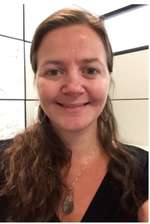Tabetha S. Boyajian
| Tabetha S. Boyajian | |
|---|---|
 | |
| Born | c. 1980 (age 35–36) |
| Fields |
|
| Education |
|
| Thesis | Sizing up the Stars (2009) |
| Doctoral advisor | Harold A. McAlister |
| Known for | Discovery of strange light curve for KIC 8462852 |
|
Website www | |
Tabetha Suzanne Boyajian (born c. 1980) is an American astronomer on faculty at Louisiana State University.[1][2] She was a post-doctoral fellow 2012–16 at Yale University, working with Debra Fischer.[2] Boyajian is active in the astronomical fields of stellar interferometry, stellar spectroscopy, exoplanet research, and high angular resolution astronomy, all particularly at optical and infrared wavelengths. She is the lead author of the September 2015 paper Where's the Flux? which investigates the highly unusual light curve of KIC 8462852;[3] the star has been colloquially named Tabby's Star in her honor.[4]
Background
Boyajian received a B.S. degree from the College of Charleston in 2003, an M.S. degree in Physics from Georgia State University in 2005, and a Ph.D. degree from the same university in 2009.[5] She studied the sizes of nearby stars similar to the Sun, using the University's CHARA array, a long-baseline optical and infrared interferometer located at Mount Wilson Observatory. Boyajian was awarded a Hubble Fellowship, and stayed at Georgia to study sizes of nearby stars much smaller than the Sun and stars with planets.[6][7] Fellow astronomer Sarah Ballard has used Boyajian's "truly remarkable"[8] work creating this "precious sample"[8] of data on nearby small stars for the "characterization by proxy" method to help investigate the far more distant exoplanet Kepler-61b.[8][9]
As of 2015, Boyajian is secretary and steering committee member of Division G Stars and Stellar Physics of the International Astronomical Union.[10]
Boyajian is also manager of the Planet Hunters project in which amateurs analyze data from the Kepler space observatory.[11]
See also
Historical Yale women astronomers:
References
- ↑ "Welcome". Yale University. Archived from the original on July 23, 2016.
- 1 2 "Exoplanets: Postdoctoral Associates & Fellows". Yale University. Archived from the original on July 1, 2016.
- ↑ Boyajian, T. S.; LaCourse, D. M.; Rappaport, S. A.; Fabrycky, D.; Fischer, D. A.; Gandolfi, D.; Kennedy, G. M.; Liu, M. C.; Moor, A.; Olah, K.; Vida, K.; Wyatt, M. C.; Best, W. M. J.; Ciesla, F.; Csak, B.; Dupuy, T. J.; Handler, G.; Heng, K.; Korhonen, H.; Kovacs, J.; Kozakis, T.; Kriskovics, L.; Schmitt, J. R.; Szabo, Gy.; Szabo, R.; Wang, J.; Goodman, S.; Hoekstra, A.; Jek, K. J. (September 15, 2015). "Planet Hunters X. KIC 8462852 - Where's the Flux?". arXiv:1509.03622
 [astro-ph.SR]. Submitted to Monthly Notices of the Royal Astronomical Society.
[astro-ph.SR]. Submitted to Monthly Notices of the Royal Astronomical Society. - ↑ Newsome, John (16 October 2015). "Space anomaly gets extraterrestrial intelligence experts' attention". CNN. Retrieved 16 October 2015.
- ↑ CV Dr. Tabetha Suzanne Boyajian - scientific literature digital library CiteSeerX
- ↑ "NASA Announces 2009 Astronomy and Astrophysics Fellows" (Press release). Space Telescope Science Institute. February 25, 2009. Retrieved October 18, 2015.
- ↑ "GSU astronomy graduate student receives Hubble Fellowship to explore stellar sizes" (Press release). Georgia State University. Archived from the original on May 3, 2009.
- 1 2 3 Kelly, Peter (April 25, 2013). "Astronomer studies far-off worlds through 'characterization by proxy'". UW Today. University of Washington. Archived from the original on April 29, 2013. Quoting Sarah Ballard.
- ↑ Ballard, Sarah; Charbonneau, David; Fressin, Francois; Torres, Guillermo; Irwin, Jonathan; Desert, Jean-Michel; Newton, Elisabeth; Mann, Andrew W.; Ciardi, David R.; Crepp, Justin R.; Henze, Christopher E.; Bryson, Stephen T.; Howell, Steven B.; Horch, Elliott P.; Everett, Mark E.; Shporer, Avi (April 2013). "Exoplanet Characterization by Proxy: a Transiting 2.15 R_Earth Planet Near the Habitable Zone of the Late K dwarf Kepler-61". Astrophysical Journal. 773 (2). arXiv:1304.6726
 . Bibcode:2013ApJ...773...98B. doi:10.1088/0004-637X/773/2/98.
. Bibcode:2013ApJ...773...98B. doi:10.1088/0004-637X/773/2/98. - ↑ "Tabetha Suzanne Boyajian". International Astronomical Union. September 29, 2015. Archived from the original on October 28, 2015.
- ↑ Hackett, Jennifer (October 25, 2015). "Computers Would Never Have Found 'Alien Superstructure' Star--It Required Citizen Science". Scientific American. Retrieved 14 February 2016.
External links
- Official website
- "The most mysterious star in the universe". Tabetha Boyajian at TED 2016. Video and transcript.